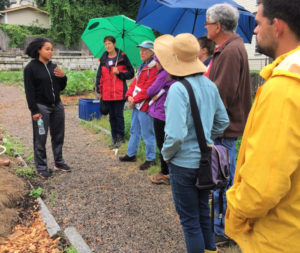 By Caro Roszell and Laura Davis, NOFA/Mass Soil Technical Advisors
By Caro Roszell and Laura Davis, NOFA/Mass Soil Technical Advisors
This fall, NOFA/Mass completed a three-year grant project exploring the management practices and soil health outcomes on six farms and gardens that use a diverse array of management practices. It gave us the opportunity to showcase our technical support approaches to the public through workshops, and to explain to growers how they can utilize different soil testing services, how to interpret their own lab test results, and how they can conduct their own field assessments for indicators of soil health.
In the process, we observed and recorded changes over time that supported* the anecdotal evidence from the farming community that:
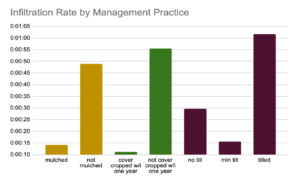
- Tillage was correlated with quantifiable soil health decline. We documented the greatest soil health declines at the farm in our cohort that was the most heavily tilled; however, that farm also experienced significant flooding in 2018, so some of the soil health declines may have been attributable to the long-term impacts of flooding.
- Cover cropping and mulching were associated with faster infiltration rate, but high organic matter soils do not necessarily infiltrate water better than soils with moderate organic matter.
- Major disturbance events can have a noticeable impact on crop and soil health, but soil health can stabilize in the absence of repeated heavy disturbance.
- There is a challenging ‘transition period’ in which some aspects of soil health can decline following a conversion to no-till / min-till practices before soil health improves.
- Established no-till management practices result in steady or improved soil health
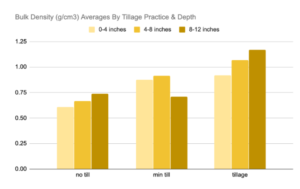
For growers, soil testing is helpful to understand limitations in soil health and in soil minerals that may lead to less than desirable crop performance. Technical assistance– whether field testing or soil lab test interpretation– can help growers make informed decisions about management practices. Furthermore, farmers benefit from understanding the best use of different types of tests, how to take them, how to compare them, and how to interpret their results. Understanding the Total Cation Exchange Capacity (TCEC) is important for the grower to know since it correlates to the amount of nutrients that the soil can hold in reserve. If the soil has a low TCEC, the grower will need to apply nutrients throughout the growing season. TCEC is a measurement of how much calcium, magnesium, potassium and sodium is present in the soil for that soil’s pH. We found that the same two soils that had lower TCEC also had lower levels of these major minerals. The TCEC is also important to understanding the cation balance for these major minerals. The goal set for the mineral balance used the Albrecht Model of Calcium 60-70%, Magnesium 10-20%, Potassium 3-5%, Sodium 1-2%, these values were dependent on soil type.
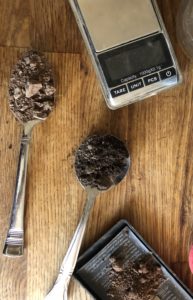
Soil samples being tested
Another important measurement from the soil test was soil organic matter (SOM). Growers learned that this measurement could help them understand the nitrogen needed to grow a crop. SOM% were very high in both min–till and no-till soils (primarily because these farms utilize compost addition as a primary production strategy; possibly secondarily because they use additional practices that preserve and protect organic matter levels like cover cropping, mulching and minimum disturbance). In addition, the lowest SOM that was found in the soils of the six growers was a field where annual tillage and regular bare-soil cultivation was practiced. The second lowest SOM% found was a farm that was tilled heavily in the past, but was in the process of being transitioned to a reduced tillage system.
Growers also benefit from learning about different field indicators of soil health. At NOFA/Mass we’re learning alongside our growers about how to use the field tests most efficiently and effectively, and which tests are most indicative of overall soil health. This project was an important opportunity for us to compare our field soil health indicators with lab-based soil health indicators. For example, infiltration rate is one of the quickest tests in the toolbox, and is often assumed to be a strong indicator of relative soil organic matter level. However, in our observations, bulk density was a much more reliable indicator of soil organic matter. Bulk density is a more labor-intensive field test than infiltration rate, but it is achievable on-farm while lab methods (loss on ignition and dry combustion) are not.
For more information about the soil health and fertility observations that we gathered over the three years of the project, you can view our full report here.
For educational videos about soil health assessment and how to interpret your lab soil tests, here are some workshops you can watch:
- Understanding Your Lab Soil Test Reports Laura Davis and Anna Gilbert-Muhammad (NOFA/Mass Resiliency Skills Series): https://www.youtube.com/watch?v=Xw5wcBcoSQg
- Soil Carbon Proxy Test Demonstration Video (CT NOFA and NOFA/Mass Soil Health Programs): https://www.youtube.com/watch?v=cmdoDjKwEo4
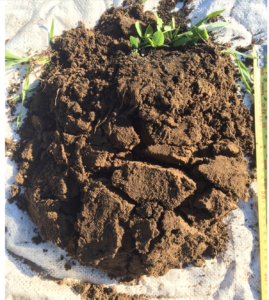
Soil aggregates demonstrated in a soil sample
For the practices and science of soil health, the NOFA community has a lot of content available online via our various YouTube Channels. Here are a few great videos to check out:
- Dr. Emily Cole of American Farmland Trust explains “The Science of No-Till Farming” https://www.youtube.com/watch?v=85ltwh-mzz0
- Julie Fine explains “Cover Cropping to Grow Our Own Nitrogen”: https://www.youtube.com/watch?v=Yu0ZrCTO4LM
- Bryan O’Hara explains Organic No-Till Vegetable Production (Part 1 of 3) https://www.youtube.com/watch?v=nojy-QtTwyY
And, of course, we always have a soil health track at our annual Winter Conference! Check out the 2021 NOFA/Mass Winter Conference program and register today!
* While our work was limited to just six farms, and therefore our data do not have statistical significance, our approach was intended to provide some quantification and record-keeping to help explore (and to either support or challenge) farmer-to-farmer observations about the relationship between management practices and resulting physical and chemical soil features.





